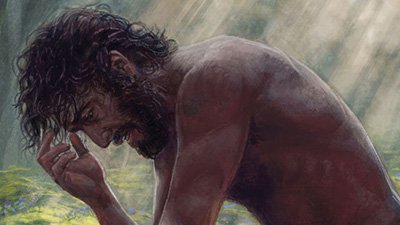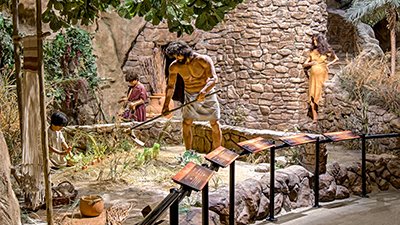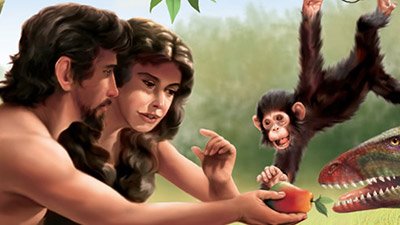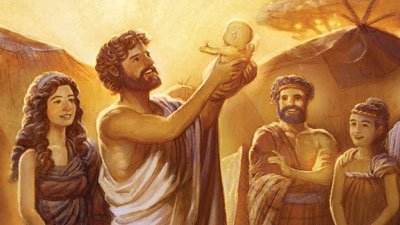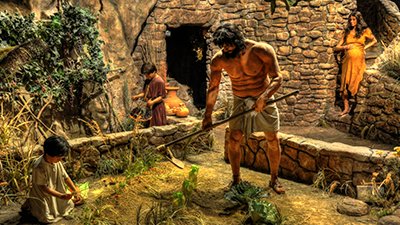Adam and Eve
Who were Adam and Eve? How do the latest scientific discoveries support the biblical account of Adam and Eve? What are the answers to the major questions concerning humanity's first parents?
Adam and Eve were real people. But because the best accounts of Adam and Eve are found in the Bible, many critics challenge their existence. Throughout the years, opponents to the historicity of Adam and Eve have challenged the biblical record on several fronts. Even Christians, including Bible college and seminary professors, have argued against a historical Adam and Eve. Often because of evolutionary thought, many claim they were mythological or allegorical figures with no basis in actual history. But are they right?
Our aim is to examine Adam and Eve from the Bible, consider some of the theological implications of believing in a real Adam and Eve, and finally address some of the major challenges to the historicity of the first humans.
Contents
- Biblical Record: Who Were Adam and Eve?
- Theological Importance of Historical Adam and Eve
- Challenge: Weren’t Adam and Eve Mythological Figures?
- Challenge: Wasn’t Genesis 1–11 Poetry?
- Challenge: Why Didn’t Adam and Eve Immediately Die?
- Challenge: Time Enough for Adam to Name All the Animals?
- Challenge: Isn’t Human DNA 99% Similar to Chimps?
- Other Scientific Evidences for a Historic Adam and Eve
- Conclusion: Why Are Adam and Eve So Important?
Biblical Record: Who Were Adam and Eve?
According to Scripture, Adam and Eve were the first human beings on the planet. In Genesis, we are told God “formed the man of dust from the ground and breathed into his nostrils the breath of life, and the man became a living creature.” (Genesis 2:7). This man, called Adam, was the first human being. But God did not create Adam to be alone. We read further along,
But for Adam there was not found a helper fit for him. So the Lord God caused a deep sleep to fall upon the man, and while he slept took one of his ribs and closed up its place with flesh. And the rib that the Lord God had taken from the man he made into a woman and brought her to the man . . . . The man called his wife’s name Eve, because she was the mother of all living. (Genesis 2:20–22, 3:20)
In the plain reading of Genesis 1–3, we learn that God created the first two people: Adam and Eve. They were placed in the Garden of Eden and given everything they needed: food, work, companionship, and fellowship with God as they walked with him in the cool of the day (Genesis 3:8). It was perfect—almost.
Then something happened.

A serpent entered the Garden of Eden to tempt Adam and Eve. God had given food from every tree in the garden but commanded the man and woman not to eat from the Tree of the Knowledge of Good and Evil. Eve believed the serpent, ate of the fruit, then gave it to Adam who also ate of the fruit (Genesis 3:6).
This event was catastrophic. Now known as the fall, God judged Adam and Eve for disobeying his command. And true to his word, Adam and Eve began the process of death. The Bible tells us that Adam lived for 930 years and then he died (Genesis 5:5).

Theological Importance of Historical Adam and Eve
Adam and Eve died because of the fall, but the fall didn’t just affect them.
Since their sin, every other person born after them was plunged into rebellion against God’s order. That includes you and every other human being you know. And this rebellion is also the reason we die today. Through Adam’s sin, death came into the world (Romans 5:12).
But Jesus demonstrated he has power over death. Jesus came, lived, was crucified, and rose from the dead (Luke 24:46). Those who are in Christ will not have to suffer the eternal consequences of sin. Through Adam sin entered the world, but through Christ, we can be saved from the punishment of sin.
That’s why a historical Adam and Eve are so important. If you deny a real Adam and real Eve, many of the doctrines in the Bible (including the gospel) would be incoherent. On many occasions, New Testament authors connect a historic Adam and Eve to foundational doctrine and it does not make sense if Adam and Eve were mythological
Consider the following passages that refer back to a historic Adam and Eve.
- Jesus affirms the special creation of Adam and Eve at the beginning (Mark 10:6).
- Luke connects the human lineage of Jesus to Adam (Luke 3:38).
- Jesus links the doctrine of marriage to Adam and Eve (Matthew 19:4–6).
- Paul connects the doctrine of the church to Adam and Eve (Ephesians 5:30–32).
- Paul argues for family order because of Adam and Eve (1 Corinthians 11:8–12).
- Paul attaches the origin of sin in the world to Eve (1 Timothy 2:13–14).
- Paul also connects death from sin to Adam (Romans 5:12–14).
By connecting to their real existence and activities, the New Testament overwhelmingly affirms the historicity of Adam and Eve. It’s not possible to deny a real Adam and Eve while at the same time believing the rest of the Bible. Hence it is vital to believe in an actual Adam and Eve to maintain a coherent biblical theology.
Paul underscores why a historical Adam was so important. “For as in Adam all die, so also in Christ shall all be made alive.” (1 Corinthians 15:22). The apostle said that we suffered the consequences of our sins because of a real Adam, but also that in a real Christ we can overcome a real death and be reconciled with the real God.
But not everyone believes the Bible about Adam and Eve. There are many attempted challenges to the history and theology connected to an actual Adam and Eve. Here are some of the more popular disagreements with the Bible’s account of our first parents.

Challenge: Weren’t Adam and Eve Mythological Figures?
Evolutionary thought permeates our culture.
In its popular form, evolutionists argue for the common descent of human beings from other animals or human-like creatures. According to them, Adam and Eve could not have been created in the way a plain reading of Genesis 1–2 suggests, since modern humans evolved from pre-existing creatures.
These critics seek to mythologize or allegorize the narrative of the first few chapters of Genesis. For instance, when recounting the narrative of Adam and Eve, The Washington Post proposed:
First, the story existed as myth, inspired in part by the Babylonian creation story, then Saint Augustine made it fact, and biblical literalism reigned for centuries until the Enlightenment, when representation of the couple in art and literature became so accurate that they seemed too human, too real, and people started asking questions, and before long secularism and science turned the story back into myth.
But is that accurate? This does not read the Bible as an integrated whole.
The biblical authors knew what mythology was. On numerous occasions, they clearly distinguish historical fact from mythology (1 Timothy 4:7; 2 Peter 1:16). So when the Bible itself argues for the historicity of Adam and Eve as Jesus, Luke, and Paul did (see above), it affirms the historicity of Adam and Eve. Later, teachers may have also affirmed the reality of Adam and Eve, but so did the authors of Scripture before them. That’s why a mythological or merely allegorical Adam and Eve does not match the rest of biblical teaching.
Challenge: Wasn’t Genesis 1–11 Poetry?
Another similar challenge to the historicity of Adam and Eve relates to the genre of Genesis. In other words, we shouldn’t believe Adam and Eve were real people because we find the primary account of their lives in a poetic section of Scripture. According to this view, Adam and Eve were merely poetic devices.
Like the first challenge, this argument doesn’t work for the same reasons. Jesus and other New Testament authors refer to Adam and Eve as historical figures. That means the biblical authors read the first chapters of Genesis as history. To deny the historicity of Adam and Eve by turning them into literary characters, one also must deny what Jesus taught (Mark 10:6).

Dr. Terry Mortenson also agrees when he said:
The early chapters of Genesis are not poetry, a series of parables or prophetic visions, or mythology. The chapters recount God’s acts in time-space history: acts of creation, providence, and redemption.
When we insist that Genesis 1–11 is history, we are not saying that this section of the Bible is only history, i.e., that it was only inspired to satisfy some of our curiosity about origins. It is far more than history, for it teaches theology, morality, and redemption, and those truths are vitally important. But Genesis 1–11 is not less than history, and what it teaches on the latter themes is rooted in that history.
Challenge: Why Didn’t Adam and Eve Immediately Die?
Yet another different challenge is an internal critique of Genesis. God promised Adam and Eve a certain judgment if they ate the forbidden fruit:
[B]ut of the tree of the knowledge of good and evil you shall not eat, for in the day that you eat of it you shall surely die. (Genesis 2:17)
How is one supposed to reconcile the fact that God promised a particular judgment for a particular sin with a judgment that was not fulfilled? Put another way, why didn’t Adam and Eve die immediately when they ate the fruit? Bodie Hodge addresses this supposed contradiction. . .
The Hebrew is, literally, die-die (muwth-muwth) with two different verb tenses (dying and die), which can be translated as “surely die” or “dying you shall die.” This indicates the beginning of dying, an ingressive sense, which finally culminates with death.
At that point, Adam and Eve began to die and would return to dust (Genesis 3:19). If they were meant to die right then, the text should have simply used muwth only once, which means “dead, died, or die” and not beginning to die or surely die (as muwth-muwth is used in Hebrew). Old Testament authors understood this and used it in such a fashion, but we must remember that English translations can miss some of the nuances.

Challenge: Time Enough for Adam to Name All the Animals?
Still others have challenged the historical record in that Adam could not possibly have named all the animal species in one day. Adam named all the animals on day 6. And he must have named all the animals in one day, because that was the rationale for God creating the woman (Genesis 2:20)—since she was also created on day 6. According to Scripture,
Now out of the ground the Lord God had formed every beast of the field and every bird of the heavens and brought them to the man to see what he would call them. And whatever the man called every living creature, that was its name. (Genesis 2:19)
There are currently millions of species of animals on the earth. The question is how could Adam have named all the animals on a single day? The narrative strains at believability if we are to believe Adam named millions of animals in less than a day.
But consider the situation.
In the first day, Adam named all the animals created at that time. It is likely that Adam had to name only a couple thousand proto-species of land animals—a task which could easily have been achieved in a few hours. Assuming Adam had to name 2,500 proto-species, or kinds (mostly at the family level of taxonomy), at 5 seconds per animal, it would have taken him approximately three and a half hours to complete the task. This was very doable, even for a person today.
Challenge: Isn’t Human DNA 99 Percent Similar to Chimps?
Others have challenged the possibility of a historic Adam and Eve on evolutionary grounds. They contend that human DNA is so similar to chimpanzee DNA, thus making our first parents unnecessary. Mainstream numbers change, but studies have suggested that human and chimp DNA is about 95–99% similar. Is that possible?
Although the DNA studies do confirm similarities between human and chimp DNA, the latest research by geneticist Jeffrey Tomkins puts the similarities closer to 80-88% compared to 95-99%. And that number may be modified even further as more research comes to light.
Taking the more reliable results provided by the earlier BLASTN version corroborated by the whole chromosome alignments of Nucmer obtained in this study, it is likely that the 88% similarity number is considerably more accurate than other methods to date. Additionally, studies show that chimpanzees have a genome size about 8% larger than humans, so “the actual genome similarity with human, even using the high end estimate of 88% for just the alignable regions, is realistically only about 80% or less when the cytogenetic data is taken into account,” according to the latest Tomkins study.
Other Scientific Evidences for a Historic Adam and Eve
The Bible affirms the historic accounts of Adam and Eve. However, there’s even more scientific literature that confirms the historicity of the first parents. In a well-documented presentation, Dr. Georgia Purdom outlines several reasons we should trust the Bible when it talks about Adam and Eve.
Conclusion: Why Are Adam and Eve So Important?
The Bible confirms the historicity of Adam and Eve. They were real people, specially created by God, and every person born is related to them. Moreover, there is nothing in scientific research that has been able to disprove the existence of Adam and Eve.
Most importantly, the gospel is dependent upon an actual Adam and Eve. Both in the New Testament (Romans 5:12–14) and in the Old Testament, we see a historical Adam and Eve connected to the promised Messiah. When God judged the serpent after the fall, there was a glimmer of hope that he hid in the judgment:
I will put enmity between you and the woman, and between your offspring and her offspring; he shall bruise your head, and you shall bruise his heel. (Genesis 3:15)
Theologians understand this “offspring” of the woman to be none other than Jesus Christ. And just as Eve found hope in God’s promised offspring, so also we look to God’s promised offspring of redemption, the Lord Jesus Christ.
Adam and Eve Topics
-
A Response to Adam and the Genome
Adam and the Genome illustrates that, as new scientific data accumulate, evolutionists find new and more nuanced ways to contradict the Bible.
News About Adam and Eve
-
June 16, 2025 from Ken Ham Blog
According to recent data, most mainline Protestant pastors don’t believe the Bible, undermining the gospel as a result.
-
Sept. 27, 2021 from Ken Ham Blog
Evolutionary story suggests clothing was made many tens of thousands of years ago while ignoring the biblical account.
-
Feb. 15, 2018 from Ken Ham Blog
According to a female rabbi and professor, Eve was the first victim of #MeToo, the recent movement to raise awareness of sexual harassment and assault.
Articles About Adam and Eve
-
April 8, 2025 from Answers in Depth
Rejecting the historical Adam comes with serious theological consequences.
-
March 10, 2024 from Answers Magazine
When we deny the existence of a literal Adam, we undermine the very authority of Scripture.
-
Aug. 22, 2023 from Demolishing Supposed Bible Contradictions: Volume 1
Why would God tell Adam and Eve to “replenish” the earth in Genesis 1:28 if they were the first humans?
-
A Literal Adam Is Not the IssueJuly 6, 2022
A defense of only the historical Adam without the rest of the creation account is incomplete.
-
Oct. 27, 2021 from Searching for Adam
It is claimed that the Bible does not deal with the issue of the age of mankind or even how man came into existence.
-
Feb. 21, 2021 from Searching for Adam
Genetics confirms the recent, supernatural creation of Adam and Eve and refutes the evolutionary narrative on human origins.
-
July 14, 2020 from Searching for Adam
How the fossil record, evolutionary assumptions, artistic license, and anatomical differences do NOT confirm common ancestry between humans and apes.
-
June 1, 2017 from Answers in Depth
Because of the impact of evolution on the theological world today, an increasing number of evangelical scholars are denying Adam’s historicity.
-
April 27, 2017 from A Response to Adam and the Genome
The recent publication of Adam and the Genome illustrated how evolutionists find new and more nuanced ways to contradict the biblical account.
-
March 1, 2017 from Searching for Adam
Does it really matter what we believe about Adam? Yes it does! There are enormous moral and spiritual implications of these truths.
-
Feb. 10, 2017 from Answers Magazine
Eve found hope in the same promised Seed that we all look to.
-
Nov. 14, 2016 from Answers Magazine
Many women have the impression that the Genesis account of Adam and Eve imposed a humiliating, subservient role on women. Is this really the case?
-
Sept. 21, 2016 from Answers in Depth
Due to a mixture of biblical and secular reasons, an increasing number of evangelical scholars are beginning to deny the supernatural creation of Adam.
-
The Consequences of Denying a Supernatural Creation of AdamNov. 30, 2015
The issue is not whether a person can be a Christian and believe in evolution but what one has to concede theologically in order to hold to their belief.
-
May 31, 2015 from Answers Magazine
The Bible is full of historical accounts, but they leave out fascinating details that we’d love to know more about. Is it okay to look further?
-
Magazine Department ArticleGood-bye AdamJan. 1, 2015 from Answers Magazine
Christian scholars like Giberson are ultimately placing evolutionary ideas in authority over God’s clear teaching in the Bible on origins.
-
Magazine Department ArticleAdam Settles In at Bryan CollegeJuly 1, 2014 from Answers Magazine
Bryan College in Tennessee was founded to honor William Jennings Bryan, the man who defended creation at the 1925 Scopes trial.
-
Magazine Department ArticleThe True Account of Adam & EveJan. 1, 2013 from Answers Magazine
Ken Ham, president of Answers in Genesis, sets the record straight in The True Account of Adam & Eve.
-
Mutilating God’s Word: Adam, Bilbo, and Peter EnnsDec. 14, 2012
Dr. Terry Mortenson, AiG-U.S., responds to a recent blog post by Dr. Peter Enns that strongly accused Ken Ham of teaching obvious error and misleading Christians.
-
Magazine Department ArticleExiles from EdenApril 4, 2012 from Answers Magazine
Far from being a secondary issue, the Genesis account of Creation and the Fall is central to our understanding of who we are and why we need a Savior.
-
Book ChapterEve’s Birth CertificateMarch 6, 2012 from Demolishing Supposed Bible Contradictions: Volume 2
Genesis 1 and 2 seem to indicate different times for the creation of Eve. Was Eve created on Day Six or not?
-
Magazine Department ArticleThe Bible Is Clear: Adam Was a Historical PersonJan. 1, 2012 from Answers Magazine
Did God create the first human being from nonliving matter and breathe life into him, or is another interpretation possible? Scripture doesn’t leave room for doubt.
-
Magazine ArticleFrom One Flesh—Or Two?Dec. 11, 2011 from Answers Magazine
Were Adam and Eve human-like animals before God transformed them into His image?
-
Feedback Article“The Search for the Historical Adam” and Population GenomicsJune 3, 2011 from Feedback
The June 2011 issue of Christianity Today spends a lot of ink searching for the historical Adam or explaining why we shouldn’t expect there to be one.
-
Magazine Department ArticleEncouraged By EveApril 1, 2011 from Answers Magazine
Although the Bible is filled with sadness, it is also filled with hope!
-
Adam and OrthodoxyFeb. 21, 2011
Darrel Falk of BioLogos recently presented an article proclaiming the coming acceptance of evolution among evangelical Christians. He intends to fight against the biblical idea of a young earth.
-
Does the “New Perspective on Paul” Undermine a Historical Adam?Jan. 31, 2011
There has been a lot of talk recently about a New Perspective on Paul (NPP). Writers previously thought to be evangelicals have used this new idea to open an assault on Adam and Eve.
-
Feedback ArticleAn In-Depth Look at the Translation of the Hebrew Word AdamJan. 20, 2006 from Feedback
“Why is Adam translated either man or mankind and not Adam?”
-
Magazine ArticleHow Could Adam Have Named All the Animals in a Single Day?June 1, 2005, pp. 27–28
How could Adam have named millions of different species on Day 6 if it was only 24 hours? This is a common objection to a straightforward view of Genesis 1.
-
Magazine ArticleWas Adam a UFO (Unidentified Figurative Object)?June 1, 1999, pp. 42–43
Many evangelical Christians don’t realize the importance of the Genesis record and its implications on other areas and doctrines of the Bible.
-
Magazine ArticleDid Eve Eat an Apple?Dec. 1, 1997, pp. 40–41
Despite the large number of cartoons and the almost universally accepted tradition, the Bible does not say that Eve ate an apple. Why then is it so popular to believe that she did?
-
Magazine ArticleDid Adam Have a Belly-Button?June 1, 1996, pp. 6–7
Did Adam have a belly-button? I believe we really have an answer to that, and we can say, 'No — Adam didn't. Neither did Eve.'
-
Magazine ArticleAdam's RibMarch 1, 1996, pp. 4–5
Adam's rib is not a topic you'd expect to be discussed in courses promoting evolution. So I was intrigued to read in Discover magazine that the subject of Adam's rib arose repeatedly.
-
Magazine ArticleWhy 'Adam' never met 'Eve'Dec. 1, 1994, pp. 29–30
This highlights the uncertainties and complexities of attempts to reconstruct the past. It is at present just as consistent with the data to state that the real Adam and Eve lived in the same place.
Recommended Resources

Answers in Genesis is an apologetics ministry, dedicated to helping Christians defend their faith and proclaim the good news of Jesus Christ.
- Customer Service 800.778.3390
- Available Monday–Friday | 9 AM–5 PM ET
- © 2026 Answers in Genesis






